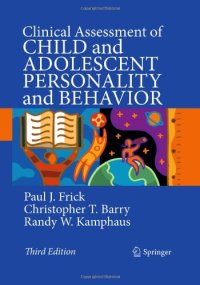
Ebook: Clinical Assessment of Child and Adolescent Personality and Behavior
- Genre: Medicine // Clinical Medicine
- Tags: Child and School Psychology, Psychotherapy and Counseling, Education (general)
- Year: 2010
- Publisher: Springer US
- Edition: 3
- Language: English
- pdf
As the knowledge base of child clinical and pediatric assessment continues to grow rapidly, so does the need for up-to-date information, explanations, and references—especially now, as commonly used tests are revised and reevaluated regularly, and evidence-based assessment has become the standard for practice. The Third Edition of Clinical Assessment of Child and Adolescent Personality and Behavior is an ideal update, designed to help graduate students and practitioners meet the challenges of assessing – and improving services to – these young clients.
This highly accessible research-to-practice text offers the depth of coverage necessary to understand the field. It is firmly rooted in current knowledge on psychopathology and normative development. The authors review the various types of measures used to assess children’s emotion, behavior, and personality, and they provide clear recommendations for their use. In addition, they emphasize skills, from rapport building to report writing, that are crucial to clinical expertise regardless of theoretical background. Finally, the authors provide clear guidelines for conducting evidence-based assessments of some of the most common forms of psychopathology experienced by children and adolescents.
This new edition:
- Focuses on key psychological constructs in child and adolescent development that are important for guiding the assessment process.
- Provides current research findings to encourage evidence-based practice.
- Compares tests and assessment methods so that readers can make the most appropriate choices.
- Provides clear guidelines for using various assessment methods in clinical assessments.
- Provides guidelines in such important areas as legal and ethical issues, cultural considerations, and communication of assessment results.
- Features case examples, text boxes, and other aids to comprehension.
- Includes special chapters to guide evidence-based assessment of ADHD, conduct problems, depression, anxiety, and autism spectrum disorders.
Clinical Assessment of Child and Adolescent Personality and Behavior is a valuable updated resource for graduate students as well as veteran and beginning clinicians across disciplines, including school and educational psychology, clinical child and adolescent psychology, and counseling psychology.
Psychologists offer an increasing variety of services to the public. Among these services, psychological assessment of personality and behavior continues to be a central activity. One main reason is that other mental health professionals often do not possess a high level of competence in this area. And when dealing with children and adolescents, psychological assessment seems to take on an even greater role. Therefore, it follows that comprehensive graduate-level instruction in assessment should be a high priority for educators of psychologists who will work with these youth. This textbook is organized into three sections, consistent with the authors’ approach to teaching. Part I provides students with the psychological knowledge base necessary for modern assessment practice, including historical perspectives, measurement science, child psychopathology, ethical, legal, and cultural issues, and the basics of beginning the assessment process. Part II gives students a broad review of the specific assessment methods used by psychologists, accompanied by specific advice regarding the usage and strengths and weaknesses of each method. In Part III, we help students perform some of the most sophisticated of assessment practices: integrating and communicating assessment results and infusing assessment practice with knowledge of child development and psychopathology to assess some of the most common types of behavioral and emotional disorders in youth. A text focusing on assessment practices must be updated every four to six years to keep pace with advances in test development. For example, several of the major tests reviewed in the text, such as the Behavioral Assessment System for Children and the Child Behavior Checklist, have undergone major revisions since the publication of the last edition making the current content outdated. Further, another major test, the Conners’ Rating Scales, is undergoing substantial revisions that should be completed before publication of the next edition. Finally, the evidence for the validity of the tests and the recommendations for their appropriate use evolve as research accumulates and requires frequent updating to remain current. For example, there was a special issue of the Journal of Clinical Child and Adolescent Psychology published focusing on evidenced-based assessment of the major forms of childhood psychopathology that will need to be integrated into the chapters in Part 3. This latter point reflects an important trend in the field that should influence the marketing of the book. That is, there are several initiatives being started in all of the major areas of applied psychology (e.g., school, clinical, and counseling) to promote evidenced-based assessment practices. These initiatives have all emphasized the need to enhance the training of graduate students in this approach to assessment. This has been the orientation of this textbook from its first edition: that is, Clinical Assessment of Child and Adolescent Personality and Behavior has focused on using research to guide all recommendations for practice. The ability of the textbook to meet this training need should be an important focus of marketing the book to training programs across all areas of applied psychology.